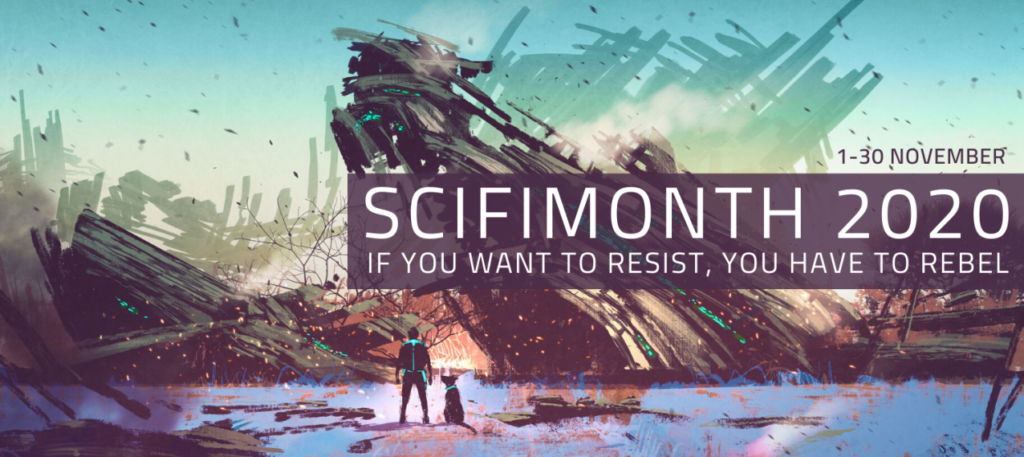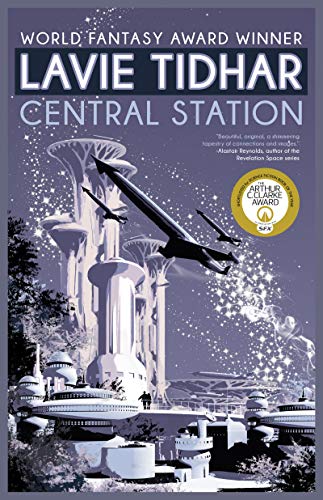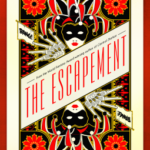
Lavie Tidhar creates a border city, a liminal place in Central Station that captures in great human depth a future world of interwoven nationalities, identities, destinies and lives. The city around Central Station, a vast spaceport in what was once called Israel or Palestine between the Arab and Jewish areas is one of many blended peoples, Chinese and Russian, Nigerian and Filipina, robot and human, believers and unbelievers, humans and the fully digitized Others.
“Arab or Jew, they needed their immigrants, their foreign workers, their Thai and Filipino and Chinese, Somali and Nigerian. And they needed their buffer, that in-between -zone that was Central Station, old South Tel Aviv, a poor place, a vibrant place— and most all, a liminal place. A border town.”
Central Station, Tachyon paperback edition, p37

It is a world in which most people are “noded” or connected to the Conversation, the vast network of voices across the world and the settled solar system. Almost everyone is connected all the time. Yet by focusing on a few families of misfits in this liminal city, including some who live silently and “unnoded”, Tidhar touches on the deepest meanings of love, relationships, personal fulfillment, religion and death. That’s saying a lot, but Tidhar pulls it off beautifully.
There is so much about love and relationships in this moving novel, yet it remains firmly in the science fiction world. Nor would I call Central Station scifi romance. Its gritty realism presents in detail a future Tel Aviv, a Jewish section to the north, a reclaimed Arab Jaffa to the south, and in between a buffer surrounding the towering grand structure of the Central Station spaceport. The border city brings out the darker side of its inhabitants’ dreams and forces them to accept a more broken reality.
Within its shadow is the border city of immigrants and misfits we get to know well, not just its people, many of them marginalized for one reason or another, but also its religions, its ways of supporting itself, its prejudices and addictions. It is a liminal place in many senses.
A woman, Miriam Jones, Mama Jones who owns a small tavern, takes a little boy named Kranki to the station once a week in the hope that his father will return, though the boy is not her son, and never had a father or mother, having been generated in a lab. He is looking for the love of a father for a son. She indulges him until one day a man appears who is, in a sense, his father and Miriam’s former lover. He is Boris Chong, a doctor who oversaw the birthing labs where Kranki was born.
A bookseller, Achimwene Haile Selassie Jones, obsessed with the pulp fiction stories of the past hundreds of years, who has no node, falls in love with a wild woman who is no longer human, but Strigoi, or Shambleau. She is Carmel, a vampire who feeds on data from connected humans. The bookseller is safe from her as a basic human, alone in his unconnected world. With him she can begin her path to finding her own human core once again. Achimwene thinks of his life as a story that shifts from one genre to another but none of them working out neatly.
There is a Saint Cohen, the now worshipped originator of the Others, the entities who evolved their own lives as purely digital entities. There is R. Brother Patch-It, the reverend robot who has been performing ceremonies for humans for hundreds of years. He preaches that “Consensus reality is like a cloth…It is made of many individual strands, each of which is a reality upon itself, a self-encoded world.” Tidhar enters these worlds and weaves them together brilliantly.
There is Zhong Weiwei, founder of the Chong family, who visits an Oracle to have his simple wish granted that he always be remembered. This meant that each of his descendants would carry all the memories of each member of the family as if they were their own. So experience for Boris is constantly conflated with the memories of the rest of his family. Being connected can be hard as well as liberating.
There is Isobel Chow, captain of a spaceship in the world of virtual reality, who is looking for love from the robot Motl, a retired and broken down war machine known as a Robotnik, who returns her affection.
Tidhar weaves the stories together of people who live as neighbors and know each other. As one character sees another in the street, we move effortlessly to the mind of that passer-by and are quickly drawn into their story. There are saints and oracles, lab-bred children who are older than their years, people from colonies on Mars, the Moon, the Belt arriving at Central Station all the time, organic humans grafted to cyborg bodies, Robotniks, those soldiers of lost wars, now rusting away as beggars.
So we move from Miriam and Kranki to Isobel and Motl to Achimwene and Carmel, to Ibrahim, the Lord of Discarded Things, and the lab-born boy he discovered as a baby and raised. The boundaries between people often fade, just as everything else in the border city is about overlapping boundaries, mixing minds, mixing histories.
Few of the characters are simply human in their physical nature, having varying types of implanted devices and connection with the digital Other, but all are deeply human in their emotional needs and experiences. Most are immersed in the Conversation, the constant stream of virtual reality pulsing through the augments or augs that most people wear. There is the rarified class of Others, those who exist in the Upload reality, a purely virtual space.
There is not so much a plot as a working out of lives of people pushed to understand who they are and what they want by their feelings for others.
This is not a long novel, but each of its chapters brings to life so many luminous moments of powerful emotional connection and builds the world of Central Station so convincingly that it feels much longer. I wish it were. It’s one of those books I savor and read slowly to keep it going. For me, Central Station is one of the classics of this century.




Leave a Reply